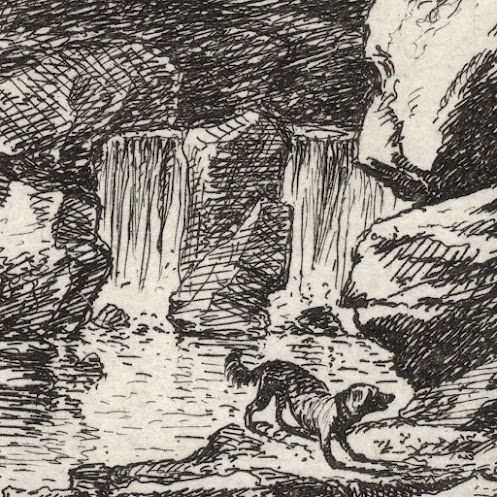Franz Joachim Beich (aka
Joachim Franz Beich) (1665–1748)
“Two Goats on the Shore of a Lake”,
c1720 (1714–1724), plate 3 from a series of six landscape
etchings in the manner of Salvator Rosa (1615–1673), published
in Augsburg by Jeremias Wolff (1663–1724).
Etching on laid paper trimmed with a narrow margin
around the image borderline and backed with a support sheet.
Size: (sheet) 23.4 x 14.8 cm; (image borderline) 23.1
x 14.5 cm.
Inscribed in plate at lower right corner with ligature
monogram of the artist’s initials within the image borderline.
State i? (of iv) before the addition of the plate
number or lettering below the image borderline of state ii. Note that although
the margin below the borderline is extremely narrow, there is no evidence of fragments
of ascending strokes in the lettering.
Nagler/Meyer 1 (Julius Meyer 1872–85, “Allgemeines
Künstler-Lexicon” [2nd revised edition of Nagler's Artist Lexicon], vol. 3, p.
338, cat. no. 1); Andresen 1 (Andreas Andresen 1864–78, “Der Deutsche
Peintre-Graveur ... von dem letzten Drittel des 16 Jahrhunderts bis zum Schluss
des 18 Jahrhunderts”, Leipzig, cat. no. 1).
The British Museum offers a description of this print:
https://www.britishmuseum.org/collection/object/P_Sheepshanks-7286.
See also the description offered by the Rijksmuseum (not reproduced): http://hdl.handle.net/10934/RM0001.COLLECT.76526.
Condition: a richly inked impression, trimmed with a
narrow margin around the image borderline and laid upon a support sheet of
archival (millennium quality) washi paper. The sheet is in an excellent
condition with no tears, holes, folds, abrasions, significant stains or foxing.
I am selling this beautifully romantic etching with
its stylistic lean towards the Baroque Italianate landscapes of Salvator Rosa,
for the total cost of AU$243 (currently US$182.89/EUR158.14/GBP133.54 at the
time of posting this print) including postage and handling to anywhere in the
world, but not (of course) any import duties/taxes imposed by some countries.
If you are interested in purchasing this marvellous
landscape executed with great spirit, please contact me
(oz_jim@printsandprinciples.com) and I will send you a PayPal invoice to make
the payment easy.
This print has been sold























































